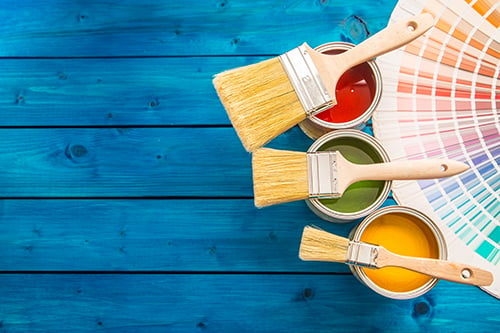How to Paint Pressure-Treated Wood
Painting Guidelines to Keep Your Fence Looking Fresh!
Not long ago we shared some best practices for wood fence protection and outlined the steps for proper wood maintenance. Finishing wood before it is exposed to destructive elements for extended lengths of time is perhaps the most important maintenance tip for any wooden structure. If you have a fence, deck, or stairs made with pressure-treated lumber, you might be wondering if you can paint pressure-treated wood to match your design preferences. You can definitely paint pressure-treated wood, though there is a certain process to follow to ensure the paint will last.
When wood is referred to as pressure-treated, it means that it was saturated with certain chemical preservatives that protect it from rot and fungus. The process is done under high pressure to allow the chemicals to penetrate better, leaving the wood rather wet. That’s why it’s important to exercise patience and allow the wood to dry thoroughly before painting; this will help you avoid peeling paint from your treated lumber. Since the chemicals used to pressure-treat wood contain toxic substances, it’s also important to use proper protection—wear gloves and a dust mask.
Follow these steps when painting pressure-treated wood to get lasting results:
1. Clean the wood
The first step in the process of painting pressure-treated wood is to remove any dirt, mold, or mildew. This can be done by scrubbing the wooden area with a stiff brush and applying soapy water. Power-washing isn’t recommended for cleaning pressure-treated wood, as it can perforate the wood, reducing the effectiveness of the pressure treatment—leaving it more susceptible to rot and fungus damage.
2. Let the wood dry

Moisture, pitch, and resin inside the wood need time to dry out before you can paint the lumber. Depending on the weather conditions, drying time for pressure-treated wood can last from a few weeks to a few months. To determine whether the wood has dried thoroughly, you can perform a small test by sprinkling water on its surface. If the wood has absorbed the water, then it’s ready for the next step. However, if the water beads up on the surface, the wood has not dried out enough.
If you are rather short on time, one option is to use kiln-dried pressure treated lumber, also called Kiln-Dried After Treatment, or KDAT. Kiln-drying involves stacking lumber in a container and applying heat to help it dry faster. Since the moisture evaporates during the drying process, kiln-dried pressure-treated wood does not warp as easily as wet lumber and you don’t have to wait as long for the wood to dry before you paint it.
3. Apply an alkyd primer
Next, use an alkyd wood primer suitable for exterior applications to ensure the paint adheres to the wood surface without peeling. You can apply primer with a paint sprayer or opt for a paintbrush if a surface requires a more detailed application. Primer also helps you fill imperfections in porous surfaces, ensures the color of your paint applies evenly, and covers the wood completely. Let the wood dry for a couple of days before moving on to the next step.
4. Finish with two coats of paint
Finally, use a high-quality exterior acrylic latex paint to coat pressure-treated wood and follow the manufacturer’s recommendations for application. Keep in mind that lighter color choices may take more than two applications to completely cover the wood’s green or brown tint. Wait a day before applying a new coat so that the paint can dry thoroughly.

Painting pressure-treated wood takes a bit of work and patience, but if you follow the steps outlined above properly, the result will be a lasting one. Other options to consider is to stain pressure-treated wood instead or let it naturally weather to a grey color and coat it with a protective sealant. Choose what works best for your maintenance routine and follow the steps for proper maintenance—it will definitely pay off in the long term.
AVO Is Here to Help!
AVO is one of the only local suppliers of cedar lumber in Southeastern MA. We specialize in quality northern white cedar at affordable prices. Our inventory includes an array of options for wood grade, thickness, and type of cut. You can view our full catalog or quickly sort choices by material, use, or type, or get inspired with our online fences and gates idea book. Don’t be intimated by buying your lumber directly from the source; you’ll have more options to choose from while saving money. We provide all of the information you need to confidently navigate our lumber yard!

